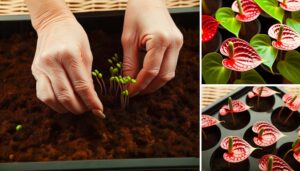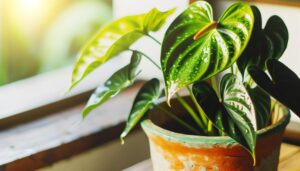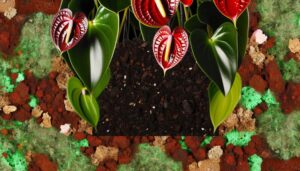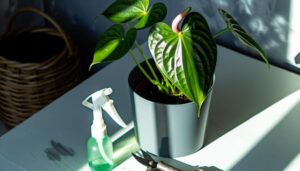How to Care for Your Chocolate Anthurium Plant
To care for your Chocolate Anthurium, place it near a window for filtered sunlight, avoiding direct sun. Use a well-draining potting mix, water when the top inch of soil is dry, and maintain soil moisture without causing root rot.
Keep the environment at 65-80°F (18-27°C) with 60-80% humidity, using a hygrometer to monitor. Fertilize every 4-6 weeks with a balanced, high-phosphorus solution.
Prune dead leaves and clean foliage regularly. Address yellowing leaves by adjusting watering, and manage pests with insecticidal soap or neem oil.
Following these steps promotes a thriving plant, and there's even more detailed info available.
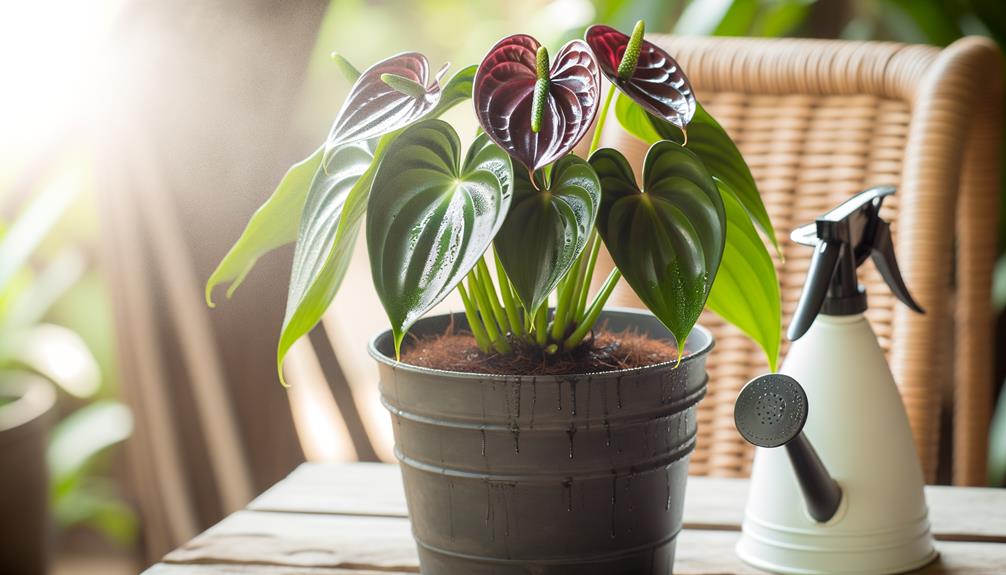
Key Takeaways
- Place near a window with filtered sunlight and rotate weekly for even exposure.
- Water when the top inch of soil is dry, ensuring thorough hydration without standing water.
- Maintain a humidity level of 60-80% using a humidifier or pebble tray.
- Fertilize every 4-6 weeks during the growing season with a diluted, balanced, water-soluble fertilizer.
- Inspect and prune regularly to remove dead leaves and spent flowers, using sterilized shears.
Light Requirements
Ensuring your Chocolate Anthurium receives bright, indirect light is crucial for its optimal growth. Position the plant near a window where it can absorb filtered sunlight. Avoid direct sun exposure, which can scorch its leaves, causing brown spots and reduced importance.
If natural light is inadequate, use fluorescent or LED grow lights, aiming for 12-14 hours of light daily. Monitor the leaf coloration; dark green leaves indicate insufficient light, while yellowing signifies excess. Rotate the plant weekly to guarantee even light exposure and balanced growth.
During winter months, when daylight is minimal, extend artificial lighting to compensate. Proper light management guarantees photosynthesis efficiency, supporting healthy foliage and vibrant blooms.
Watering Guidelines
You should water your Chocolate Anthurium when the top inch of soil feels dry to the touch.
Maintain the soil remains consistently moist but not waterlogged to prevent root rot.
Use a well-draining potting mix to maintain ideal soil moisture levels.
Optimal Watering Frequency
Water your Chocolate Anthurium plant when the top inch of soil feels dry to the touch, typically every 7-10 days. This frequency guarantees that the roots access moisture without becoming waterlogged. Use a soil moisture meter for precision.
When watering, pour until water drains from the pot's bottom, ensuring thorough hydration. Avoid letting the plant sit in standing water, as excessive moisture can lead to root rot. Early morning watering mimics natural dew and allows excess water to evaporate, reducing fungal risks.
Adjust frequency based on environmental conditions; warmer, drier climates may require more frequent watering. Regularly monitor the plant's response to your watering schedule, adjusting as necessary to maintain peak health.
Soil Moisture Levels
Maintaining proper soil moisture levels is crucial for the health of your Chocolate Anthurium. You'll need to strike a balance to keep the soil consistently moist but not waterlogged.
Follow these steps:
- Check Moisture Regularly: Insert your finger 1-2 inches into the soil. If it feels dry, it's time to water. Make sure the top layer remains slightly damp.
- Water Evenly: Use room-temperature water and pour slowly until it drains out the bottom. Avoid letting the plant sit in standing water to prevent root rot.
- Adjust for Seasons: During active growth (spring and summer), increase watering frequency. In dormancy periods (fall and winter), reduce the frequency but never let the soil dry out completely.
Proper moisture levels will keep your plant thriving.
Ideal Soil Type
For best growth, make sure your Chocolate Anthurium thrives in a well-draining soil mix to prevent root rot.
Incorporate organic matter like peat moss or compost to improve nutrient availability.
Maintain soil pH levels between 5.5 and 6.5 to support healthy plant development.
Well-Draining Soil Mix
Secure your Chocolate Anthurium flourishes by selecting a well-draining soil blend rich in organic matter and perlite. This will maximize aeration and prevent root rot.
Here's a step-by-step guide:
- Blend Components: Combine equal parts of peat moss, pine bark, and perlite. Peat moss holds moisture while pine bark and perlite improve drainage.
- Check pH Level: Aim for a slightly acidic to neutral pH (5.5-6.5). Use a soil pH tester to confirm the correct acidity level for top-notch nutrient absorption.
- Soil Texture: Ensure the blend is loose and crumbly, providing the roots with room to grow and access oxygen.
Organic Matter Importance
To secure your Chocolate Anthurium thrives, enrich the soil with organic matter like compost or well-rotted manure, which boosts nutrient content and enhances microbial activity. Organic matter improves soil structure, promoting aeration and moisture retention. It supports beneficial microorganisms that decompose organic materials, releasing essential nutrients like nitrogen, phosphorus, and potassium.
Incorporate approximately 20-30% organic matter into your potting mix. Use well-decomposed compost to avoid nitrogen depletion, which can stunt plant growth. Avoid fresh manure, as it can burn roots due to high ammonia content. Regularly top-dress with organic mulch to maintain a consistent nutrient supply.
This practice not only fosters a healthy root environment but also secures sustained growth and vibrant blooms for your Chocolate Anthurium.
Soil Ph Levels
Maximize your Chocolate Anthurium's growth by maintaining a soil pH level between 5.5 and 6.5, which supports ideal nutrient absorption and vigorous growth. To achieve this, use a well-draining potting mix rich in organic matter.
Monitor soil pH regularly using a pH meter or test kit. Adjust pH levels if necessary by incorporating amendments like sulfur to lower pH or lime to raise it.
Follow these steps to ensure ideal soil conditions:
- Test Soil pH Weekly: Regular monitoring helps you catch pH imbalances early.
- Use Appropriate Amendments: Know when to add sulfur or lime based on your pH readings.
- Choose the Right Potting Mix: Use a mix formulated for acidic-loving plants, ensuring it contains peat moss or pine bark.
Temperature and Humidity
Maintaining an ideal temperature range of 65-80°F (18-27°C) and ensuring high humidity levels around 60-80% are essential for the well-being of your Chocolate Anthurium plant.
Place your plant in a spot where it receives consistent warmth, away from cold drafts or sudden temperature fluctuations.
To achieve peak humidity, consider using a humidifier or placing a tray of water near the plant to create a microclimate. You can also mist the leaves regularly, but avoid waterlogging the soil.
Use a hygrometer to monitor humidity levels accurately. If the air is too dry, the plant's leaves may brown and curl, indicating stress.
Fertilizing Tips
When fertilizing your Chocolate Anthurium, choose a balanced, water-soluble fertilizer with a high phosphorus content to support robust blooming and vibrant foliage. Apply the fertilizer every 4-6 weeks during the growing season, which is typically from spring to early autumn.
Dilute the fertilizer to half the recommended strength to prevent nutrient burn, which can damage the roots.
Follow these steps for best fertilization:
- Mixing: Combine the fertilizer with water according to the package instructions, then dilute it to half strength.
- Application: Pour the diluted solution directly onto the soil, avoiding contact with the leaves to prevent leaf burn.
- Frequency: Maintain a consistent schedule of fertilizing every 4-6 weeks to ensure a steady nutrient supply.
These steps will promote healthy growth and vibrant blooms.
Pruning and Maintenance
Regularly prune your Chocolate Anthurium to remove dead or yellowing leaves, which helps maintain its health and encourages new growth. Use sterilized pruning shears to prevent disease transmission. Cut at the base of the leaf stem, close to the main stalk, ensuring a clean incision. This practice minimizes stress on the plant.
Remove any spent flowers to direct energy toward foliage and root development. Inspect your plant weekly for signs of decay or damage, and promptly address these issues. Wipe leaves with a damp cloth to remove dust and facilitate photosynthesis.
Maintain a consistent pruning schedule to support a robust, thriving Anthurium. Remember, a well-maintained plant is more resilient and aesthetically pleasing.
Common Issues and Solutions
Encountering problems with your Chocolate Anthurium is common, but understanding the specific issues and their solutions can ensure your plant thrives. Here are three frequent issues and how to resolve them:
- Yellowing Leaves: This often indicates overwatering. Make sure the soil is well-draining and allow the top inch to dry before watering again.
- Brown Tips: This can result from low humidity or chemical exposure. Increase humidity using a humidifier or pebble tray, and use distilled or rainwater for irrigation.
- Pest Infestations: Aphids, mealybugs, and spider mites are common pests. Treat infestations by wiping leaves with insecticidal soap or neem oil. Regularly inspect leaves for early pest detection.
Conclusion
Caring for your chocolate anthurium plant isn't just about aesthetics; it's about fostering a thriving plant.
Did you know that anthuriums can boost indoor air quality by removing toxins? By ensuring proper light, watering, soil, temperature, and humidity, you help your plant flourish.
Regular fertilizing and pruning will keep it vibrant. Address common issues promptly to maintain its health.
With these steps, you'll enjoy a stunning, air-purifying anthurium for years.

